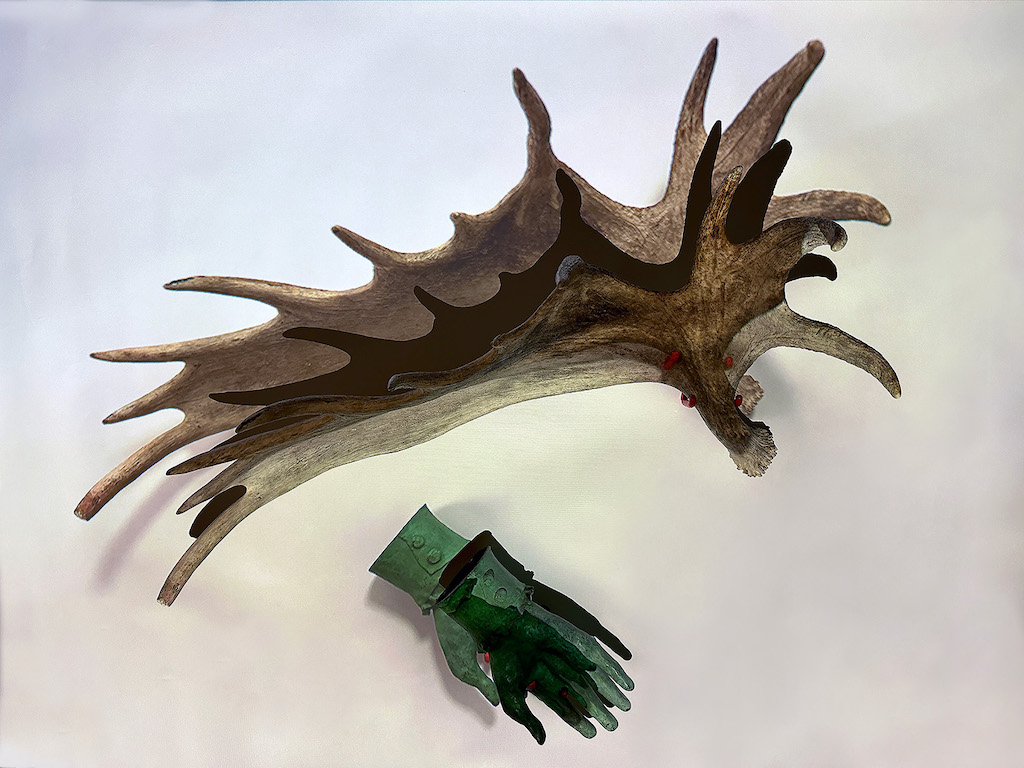Audio Description
Logan MacDonald, shed, audio description, 03:25. Courtesy of Rebecca Singh.

Logan MacDonald shed, 2024. Image courtesy the artist.
Audio Description – Transcript
This work is displayed in landscape orientation in a six tall by nine foot long lightbox with a black frame. The lower edge of this lightbox’s frame is at average height standing height shoulder level.
This colour photographic work will be described in thirds. The two photographed objects are against a white background which is mottled with shadows.
The top two thirds of the photo features superimposed photographs of a moose antler. It is light and dark brown. It is being held by a small red mounting bracket. This moose antler is positioned from the back, with the stem on the right and the antler angling down towards the left. If the moose were there it would be standing facing the work on the right side. The shape of the antler has a thick ridge of cartilage topped with 10 spikey fingers like points splayed out. The side to the left of the stem is three times longer than the side to the right. The bottom edge of the antler is flat.
In the lower third of the image is a statue’s hand. The hand is coloured black and green and resembles the colours of a weathered bronze sculpture. The hand has a shirt cuff with two buttons. It points down with its palm facing us. It also has a visible red bracket.
Both of these objects appear in superimposed layers. A crisp layer in the foreground, a shadow layer directly behind it and behind that a gauzy layer.
shed
Site Z3 on the map
shed is composed of fragmented bronze figure statues and moose shed antlers that are symbolically in conversation with one another. The work is intended to lyrically explore notions and tensions of cultural knowledge-exchange, colonial resistance, and listening. The inclusion of the bronze figures is to incorporate a calcified colonial signifier, metaphorically being decolonized. While, the moose shed antlers conceptually connect to notions of listening and rejuvenation, as they are believed to have evolved anatomically to seasonally enhance hearing–helping moose sonically locate mates and avoid predators–before naturally falling off. The antlers hold additional meaning as a signifier of and material for Indigenous material art practice, and offer a connection to the artist’s home territory. This work invites a visual and conceptual connection to cultural knowledge-exchange, with how we might collectively listen to the land and regenerate from our colonial past.

The Blackwood
University of Toronto Mississauga
3359 Mississauga Road
Mississauga, ON L5L 1C6
[email protected]
(905) 828-3789
The galleries are open. Hours of operation: Monday–Saturday, 12–5pm.
Holiday hours: regular gallery hours are in effect until and including Saturday, December 6. The galleries will then be closed for the holidays, except for regular hours on Saturday, December 13. In 2026, the galleries reopen Monday, January 5.
Facebook | Twitter | Instagram
Sign up to receive our newsletter.
The Blackwood is situated on the Territory of the Mississaugas of the Credit, Seneca, and Huron-Wendat.